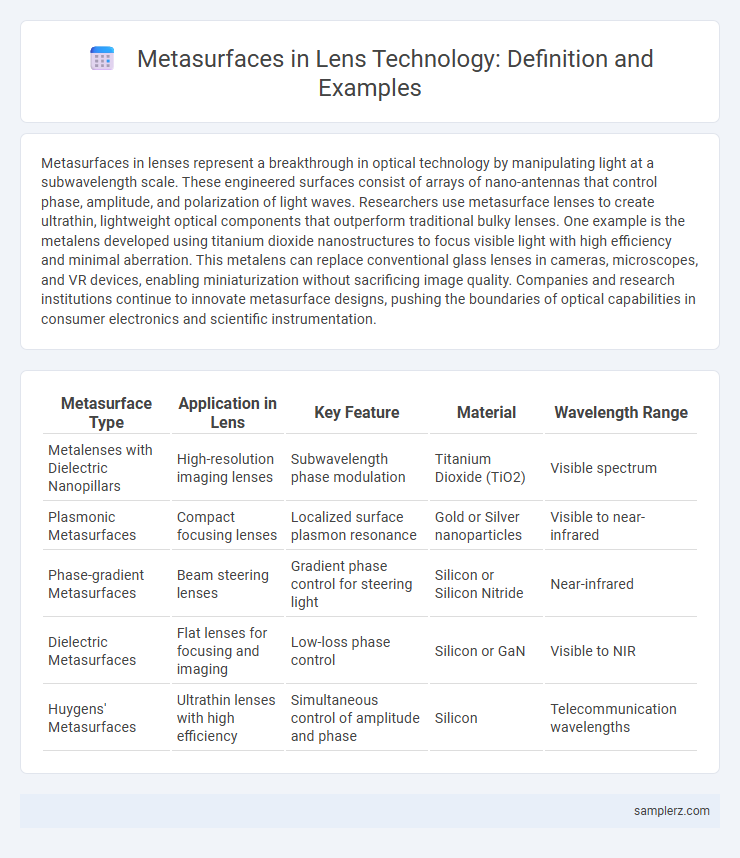Metasurfaces in lenses represent a breakthrough in optical technology by manipulating light at a subwavelength scale. These engineered surfaces consist of arrays of nano-antennas that control phase, amplitude, and polarization of light waves. Researchers use metasurface lenses to create ultrathin, lightweight optical components that outperform traditional bulky lenses. One example is the metalens developed using titanium dioxide nanostructures to focus visible light with high efficiency and minimal aberration. This metalens can replace conventional glass lenses in cameras, microscopes, and VR devices, enabling miniaturization without sacrificing image quality. Companies and research institutions continue to innovate metasurface designs, pushing the boundaries of optical capabilities in consumer electronics and scientific instrumentation.
Table of Comparison
| Metasurface Type | Application in Lens | Key Feature | Material | Wavelength Range |
|---|---|---|---|---|
| Metalenses with Dielectric Nanopillars | High-resolution imaging lenses | Subwavelength phase modulation | Titanium Dioxide (TiO2) | Visible spectrum |
| Plasmonic Metasurfaces | Compact focusing lenses | Localized surface plasmon resonance | Gold or Silver nanoparticles | Visible to near-infrared |
| Phase-gradient Metasurfaces | Beam steering lenses | Gradient phase control for steering light | Silicon or Silicon Nitride | Near-infrared |
| Dielectric Metasurfaces | Flat lenses for focusing and imaging | Low-loss phase control | Silicon or GaN | Visible to NIR |
| Huygens' Metasurfaces | Ultrathin lenses with high efficiency | Simultaneous control of amplitude and phase | Silicon | Telecommunication wavelengths |
Introduction to Metasurface-Enhanced Lenses
Metasurface-enhanced lenses utilize ultrathin, nanostructured surfaces to manipulate light with subwavelength precision, enabling unprecedented control over wavefront shaping and focusing capabilities. These lenses overcome traditional optical limitations by replacing bulky components with flat, lightweight designs that offer enhanced resolution and reduced chromatic aberration. Innovative applications in imaging systems, augmented reality, and compact optical devices demonstrate the transformative potential of metasurface technology in modern lens engineering.
How Metasurfaces Revolutionize Optical Lens Design
Metasurfaces revolutionize optical lens design by enabling ultra-thin, flat lenses with precise control over light propagation at the nanoscale. These engineered surfaces manipulate phase, amplitude, and polarization of incoming light, replacing bulky traditional lenses with compact, high-performance alternatives perfect for applications in smartphones, AR/VR devices, and advanced imaging systems. Enhanced resolution and reduced chromatic aberration in metasurface lenses demonstrate their potential to transform optical technologies across scientific and consumer markets.
Compact Imaging Lenses with Metasurface Technology
Compact imaging lenses utilizing metasurface technology achieve unprecedented miniaturization by precisely controlling light wavefronts through nanoscale structures. These metasurfaces enable high-resolution focus and aberration correction within ultrathin lens profiles, significantly enhancing imaging performance in smartphones and medical devices. By integrating tailored phase shifts across subwavelength elements, metasurface lenses outperform traditional bulky optics in both size and optical efficiency.
Metasurface-Based Flat Lenses: Metalenses Explained
Metasurface-based flat lenses, known as metalenses, leverage nanostructured surfaces to manipulate light at subwavelength scales, enabling ultra-thin, lightweight optical components with high-resolution focus. By engineering the phase, amplitude, and polarization of incoming light through arrays of nanoantennas, metalenses achieve aberration correction and broadband operation beyond conventional curved lenses. Leading innovations from institutions like Harvard and MIT demonstrate metalenses' potential in smartphone cameras, microscopy, and augmented reality devices, revolutionizing compact optical systems.
Achromatic Lenses Enabled by Metasurfaces
Achromatic lenses enabled by metasurfaces utilize subwavelength nanostructures to manipulate light across multiple wavelengths, significantly reducing chromatic aberration. These engineered metasurfaces replace bulky traditional optics with flat, ultrathin components that maintain consistent focal length for different colors. Research demonstrates improved imaging performance in applications such as microscopy, augmented reality, and compact camera systems due to enhanced color fidelity and miniaturization.
Tunable and Adaptive Metasurface Lenses
Tunable and adaptive metasurface lenses employ nanostructured surfaces to dynamically manipulate light wavefronts, enabling real-time focus adjustment without mechanical movement. These metasurfaces utilize materials like phase-change compounds or liquid crystals to modulate refractive indices, achieving high-resolution tunability across various wavelengths. The integration of adaptive metasurface lenses enhances optical devices in applications such as augmented reality, microscopy, and laser systems by providing compact, lightweight, and efficient focal control.
Polarization Control in Lens Systems Using Metasurfaces
Metasurfaces enable precise polarization control in lens systems by manipulating the phase and amplitude of incident light at the subwavelength scale. These engineered surfaces facilitate dynamic polarization state conversion, improving imaging performance and reducing aberrations in compact optical devices. Recent advances demonstrate metasurface lenses with tunable polarization responses, crucial for applications in augmented reality and polarization-sensitive microscopy.
Applications of Metasurface Lenses in Miniaturized Devices
Metasurface lenses enable ultra-thin, lightweight optical components ideal for miniaturized devices such as smartphones, AR/VR headsets, and biomedical imaging systems. These metasurfaces manipulate light at the subwavelength scale, enhancing image quality while reducing device size and weight. Integration of metasurface lenses facilitates compact optical systems with improved functionality in portable electronics and wearable technology.
Infrared and Terahertz Lenses with Metasurface Integration
Infrared and terahertz lenses with metasurface integration utilize ultrathin, nanostructured surfaces to manipulate electromagnetic waves with subwavelength precision, enabling compact, lightweight optical components. These metasurfaces achieve high-efficiency beam focusing and aberration correction by engineering phase, amplitude, and polarization profiles at the interface, greatly enhancing imaging and sensing capabilities in infrared and terahertz regimes. Advances in materials such as graphene and dielectric resonators further optimize metasurface performance, supporting applications in security scanning, spectroscopy, and wireless communication systems.
Future Developments in Metasurface Lens Engineering
Future developments in metasurface lens engineering emphasize the integration of tunable materials such as phase-change compounds and liquid crystals to achieve dynamic focal length adjustment and aberration correction. Advances in nanofabrication techniques, including electron beam lithography and nanoimprint technology, enable higher resolution and scalability for commercial applications. Computational design methods leveraging machine learning optimize metasurface patterns to enhance optical efficiency and multifunctionality in augmented reality and compact imaging systems.

example of metasurface in lens Infographic
 samplerz.com
samplerz.com